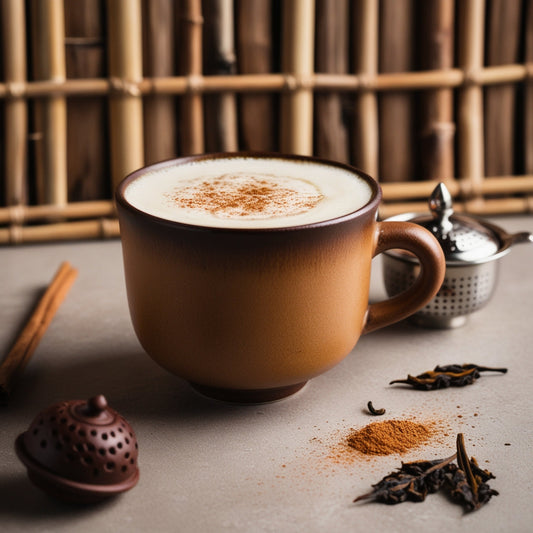Introduction
Ever wondered why tea connoisseurs are preferring Pu-erh Tea over Green Tea? Why Pu-erh best in London? Do you know that Pu-erh Tea has health benefits like promote weight loss, Inhibits cancer growth and so on. Let's take a deep dive into the Uniqueness,health benefits of Pu-erh tea and discover where to find the best Pu-erh tea in London.
Table of Content
- Introduction
- Uniqueness
- Health Benefits
- Where to Buy Authentic Pu-erh Tea
- Conclusion
Uniqueness of Pu-erh Tea
Unique Flavour of Pu-erh Tea
As ripe Pu-erh has undergone full fermentation, much of the bitterness and astringency inherent in the tea leaves have dissipated. Ripe Pu-erh is generally earthy, nutty or woody. Good quality aged Pu-erh should be mellow, smooth and offer a sweet (sugarcane or plum) aftertaste (hui tian). Poor quality ripe Pu-erh is flat, dull, thin and may have an unpleasant odour.
Cultural Appeal
According to Traditional Chinese Medicine, Pu-erh tea has a warming and potent digestive property. Chinese doctors consider Pu-erh tea to clean the body from fat, toxins of meat and oily foods. This is also why Pu-erh has such a wide appeal amongst many Asian food cultures. Tests conducted in China report that Pu-erh can lower the alcohol level in the bloodstream.
People consider Pu-erh the best cure for a hangover and consume it as a "detox tea." Many regard Pu-erh tea as the best among all teas for its body slimming function, making it a natural and safe choice for dieters. Recent research suggests that consuming 5-8 cups of Pu-erh Tea each day can reduce cholesterol and plaque of the arteries. ( outbound)
In France, Pu-erh Tea Cha is widely popular and consumed by many women as a "beauty and dieting tea". People widely consume Pu-erh in Hong Kong, Guangdong, Malaysia, Singapore, Taiwan, Tibet, Bhutan, by Himalayan cultures, and along the old Silk Road routes into Central and Southeastern Asia.
Compared to other teas, connoisseurs have a cult following for Pu-erh and regard it as a sacred relic of ancient tea cultures and traditions.

Aging Potential
Young Pu-erh tea typically has a dark red colour because of the rapid fermentation process. Additionally, as tea ages, its catechin content rises, giving young Pu-erh a more distinct, singular, and delicate flavor. The consensus is that young Pu-erh smells richly green. Young Pu-erh has a rich, full-flavored scent and a smooth, mellow texture, making it perfect for regular consumption.
Pu-erh tea in Modern Society
Pu-erh is regarded as a highly prized commodity. Even in modern society, a well-preserved pu-erh still maintains its value and remains a household treat.
The mainstream population of tea drinkers is just now being introduced to Pu-erh tea's popularity, driven by new hype from mass media about its many salubrious effects. It is only a matter of time before the beauty and benefits of pu-erh tea become commonplace household knowledge.
The difference betweeen pu-erh and green tea
Harvesting
Pu-erh tea is harvested from a special large leaf variety of Camellia sinensis, exclusively found in Yunnan, China.
In contrast, green tea is harvested from the small leaf type of Camellia sinensis, found in various parts of China, such as Jiangsu and Zhejiang.
Processing method
Raw (sheng) Pu-erh and green tea undergo similar processing methods: withering, pan-frying, rolling, and drying. Raw Pu-erh tea is dried in the sunshine, while green tea is dried with hot air.
Ripe (shou) Pu-erh tea is even more different than green tea – it is fermented after drying using the “wet piling” method.
After processing (drying for raw Pu-erh and fermentation for ripe Pu-erh), producers usually compress Pu-erh tea into cake/disc forms, unlike green teas.

Brewing method
Pu-erh tea tastes best when brewed using boiling water, while green tea requires lower temperature water to avoid burning the leaves and creating an unpleasant taste.
Flavour
Green tea usually has a sweet and light flavour, much lighter than the rich and earthy Pu-erh tea. Also, because of the fermentation process, Pu-erh tea tastes better as it ages, while for green tea, there is no need to age it.
Health Benefits
Promote weight loss
Animal and test-tube studies have shown that Pu-erhtea may help synthesize fewer new fats while burning more stored body fat which can lead to weight loss.
Additionally, pu-erh tea is fermented, so it can also introduce healthy probiotics or beneficial gut bacteria into your body.
These probiotics may help improve your blood sugar control, which plays a key role in weight management and hunger .
A single study in 36 people with overweight found that consuming 333 mg of pu-erh tea extract 3 times daily for 12 weeks resulted in significantly improved body weight, body mass index (BMI), and abdominal fat measurements, compared with a control group .
Improves cholesterol
Several animal studies have observed that supplementing with pu-erh tea extracts benefit blood fat levels .
Pu-erh tea extracts may help reduce cholesterol levels in two ways .
First, pu-erh tea increases how much dietary-fat-bound bile acid is excreted in the feces, thus keeping the fat from being absorbed into your bloodstream. (OUTBOUND).
Second, in animal studies, pu-erh tea also decreases fat accumulation. Together, these effects can decrease heart disease risk.
Yet, animal studies using concentrated extracts do not prove that drinking pu-erh tea will have the same effects in humans.
Inhibits cancer growth
In test-tube studies, (OUTBOUND) pu-erh tea extracts have killed breast cancer, oral cancer, and colon cancer cells.
While these findings offer a promising starting point for future research, pu-erh tea should not be used as a cancer treatment.
These studies involve applying highly concentrated extracts directly to cancer cells, which is not how drinking pu-erh tea would interact with cancer cells in your body.
May boost liver health
Because it can help decrease fat accumulation, pu-erh tea may help prevent or reverse non-alcoholic fatty liver disease, a disease in which excess fat accumulates in your liver. However, this has only been noted in animal research so far.
Another animal study also found that pu-erh tea extract may protect the liver from damage caused by the chemotherapy drug cisplatin.
Where to Buy Authentic Pu-erh Tea?
For a reliable selection of genuine Pu-erh tea, visit Puerh Craft. It offers a curated collection of high-quality Pu-erh teas sourced directly from Yunnan Province.
Conclusion
Pu-erh Tea has Unique flavour like earthy, nutty or woody, having a warming and potent digestive property. The differences between Pu-erh and green tea lie in harvesting, processing, brewing, and flavor. There are many Health Benefits of Pu-erh Tea like it helps in promoting weight loss, Improves Cholesterol, Inhibits cancer growth in body, boost liver health and So on.
So by adding Pu-erh tea in your daily routine you can get healthy without compromise in the taste. For most authentic and reliable selection of genuine Pu-erh tea, visit Pu-erh Craft. It offer a curated collection of high-quality Pu-erh teas sourced directly from Yunnan Province.
Q&A
Q: How is Pu-erh tea different from other teas?
A: Unlike most other teas which tend to lose their freshness and flavor soon after the time of production, Pu-erh, due to qualities inherent in its broad leaves, undergoes a fermentation process which improves its taste, texture and aroma over time.Pu-erh tea, like fine wine, is best enjoyed many years later after the tea has been aged.
Q:What is the best way to brew Pu-erh tea?
A:The best way to brew Pu-erh tea is to use the Gongfu brewing method. Using a small Yixing clay teapot or a small three-piece lidded bowl known as Gaiwan, tea is brewed quickly and then dispensed into tiny tea cups. The Gongfu brewing method allows tea drinkers to enjoy the changing flavor of the tea over the course of multiple infusions of the same leaves as they unfurl.
Q:Why is there a big difference in price among Pu-erh tea?
A:Like fine wine, Pu-erh tea’s value goes up as it ages. There are costs associated with aging the tea and the inventory of a particular tea will only decrease in time. Accordingly, the price of Pu-erh tea is adjusted at least once year, depending on their popularity and rarity. Generally speaking, the percentage of appreciation goes up most when a tea reaches its 10th year or 20th year.






